Lori Devoti's Blog
December 10, 2018
Plotting a Book Made Easy
Plotting a book scares a lot of authors. Developing characters and planning a book outline intimidates a lot of writers as well. But, honestly, none of these things are scary. They’re fun. Really.
The key to plotting a book, or planning a book outline, if that is how you prefer to think of it, is to start with your characters. Once you know them, know what they want, and what is getting in their way, the rest will flow easily.
We have a lot or articles here at the How to Write Shop to help authors with these things. Using the Enneagram for Developing Characters, The Clothesline Plot, and Plotting with the Hero’s Journey are a few I reccommend.
For those writers looking for a one-stop easy to follow guide for developing characters, plotting a book, and planning a book outline, I’ve also put together all of these things (plus more) in one book: Hello, Plot. Are You Out There?

Hello, Plot. Are You Out There? is an easy-to-follow guide that walks you through developing your characters and then the perfect plot for those characters and your story.
It also includes a free workbook with forms to download, and bonus, as readers of the How to Write Shop, you can post any questions you have here for my personal feedback.
Check it out and let me know what you think!
Available in print and ebook at: Amazon | Barnes and Noble| Smashwords | Kobo
August 16, 2018
How to Write Book Blurbs that Sell
I know you are here for some great and truly easy to use tips on how to write book blurbs that sell, but first, an admission…
I have a degree in advertising. I worked for multiple newspapers helping small business owners develop ads and advertising campaigns.
Then I became a traditionally published author and just fell into line with what publishers did so far as book blurbs.
I knew some of the blurbs for my books were just BAD, but the basic idea of what they should include, I accepted. And when I went the indie publishing route and had a chance to write my own book blurbs, I followed their example.
Stupid, stupid me.
Don’t be like Lori… at least THAT Lori. Be smart. Remember a book blurb is meant to SELL YOUR BOOK.
Don’t be shy. Sell it!
But, how?
By using some tried and true methods of advertising copywriting.
Six Tips on how to write book blurbs that sell your book Start with a hook
Start with a hookYou know what a hook is. The first line of your novel hopefully has one. The hook for your book blurb though should be a bit, well… more hooky. It should be short… try for six words or less… and it should raise some question or emotion in the reader’s mind that makes them want to read more.
Sell the sizzle, not the steakThis is an old, but valuable advertising principle.
You think people buy a product, but really people buy an emotion or an experience. They buy what they think that product will do for them.
If you want to sell a steak, you don’t just give them the bland facts… how much protein per ounce, that it comes from a cow, etc.
You sell them on hearing that sizzle on the grill. On the juicy taste. On what that protein (if you choose to highlight it) is going to do for them.
So, for your book, what is the sizzle? It’s the emotional payoff someone gets from reading it.
Where do you find this? Reviews. Look at what readers are saying about your book. If you don’t have reviews yet, look at what readers are saying about books they love in your genre. Then make it your sizzle.
Break the blurb into short sectionsReally short.
In advertising, there are different types of ads and some of them do include long blocks of copy, but for a book blurb, a big old info dump with no line breaks is not your selling friend. Go for two sentences at most before a line break.
Don’t tell us muchReaders don’t care that the hero whose name is Jack Jones went to the grocery store and met May White who owns a dog boutique. Then the two ran into a robber who grabbed May’s purse which held her much loved Pomeranian.
What do they care about? The sizzle!
With that in mind, give them just enough about the book to work in any tropes, etc. that you know readers will be looking for… friends to lovers, alpha hero, whatever. Then sell the sizzle and HOOK them.
Use a YOU statementThat’s right the dreaded second person. As novelists, we don’t use it, but in selling, it is golden.
The use of “You” reminds readers that this sizzle you are selling is going to work for them. You are talking to them.
Ask for the saleThis and the You statement seem to be the thing authors have the most trouble with. But, seriously, you need to tell people to buy the book! “Get (my fabulous book title) today!” That simple.
Okay, so now let’s put this all together, shall we?
How to Write Book Blurbs that sell… Book blurb examplefrom my Rae Davies Dusty Deals cozy mystery series
***
No one’s perfect.
At least that’s what Lucy tells herself.
Then she meets her boyfriend’s rodeo queen ex-wife.
Even her dog is perfect.
What’s Lucy going to do?
Lucy’s dog can’t herd sheep, she loses her wallet, and oh yeah…there’s that dead rodeo queen she just stumbled over.
Lucy finds herself out of money, out of love, and maybe this time, out of luck.
You’ll love this rollicking good time of a cozy mystery.
Get Cut Loose today!
***
This is a vast improvement on the facts laden blurb I had before. And, the beauty of self-publishing is that I can monitor its results and tweak as I like.
Oh, and another tip? Amazon lets you use html to format your book blurb. Use that! Here’s a link to a site to help you with this... or you can use your WordPress blog or hand code it yourself. Just be aware that Amazon has its own styles set up, so it may require some trial and error of posting and then changing to get the breaks, font size, etc. like you really want it.
I hope you found this article on how to write book blurbs that sell useful. Do you have a book blurb you are struggling with or a revised book blurb you love? Post it in the comments!
In other news… my book on how to plot is available now! Check out Hello, Plot. Are You Out There? at Amazon[image error], Smashwords, Apple, Kobo, and Barnes and Noble.
~~~

Lori Devoti is the author of paranormal romance, urban fantasy and young adult fiction. Under the name Rae Davies, she writes the USA Today Bestselling Dusty Deals Mystery series. Check out her books at www.LoriDevoti.com and RaeDavies.com. Looking for help with your writing? Lori also does developmental editing and critiques for other authors and publishers. See our Editorial Services page for contact information and pricing. Or check out Lori’s classes at the Continuing Studies Department of the University of Wisconsin.
July 18, 2018
A Very Vampire Sale!
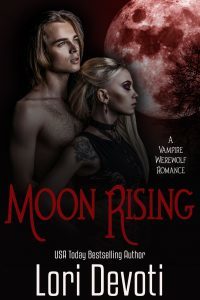
 To celebrate the re-release of my Harlequin Nocturne, Moon Rising, I’m having a sale!
To celebrate the re-release of my Harlequin Nocturne, Moon Rising, I’m having a sale!
You can get Moon Rising and Bloodlines (previously titled Trust Me) for just 99 cents each!
Both are also in Kindle Unlimited!
Both are full-length novels and a mix of mystery, romance, and supernatural thriller.
I hope you will check them out. :)
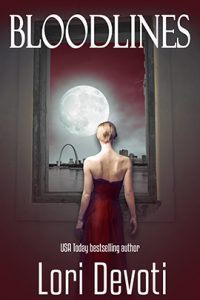 Bloodlines, originally published under the title of Trust Me, has a new cover too. designed by my daughter! I love the addition of the St. Louis skyline.)
Bloodlines, originally published under the title of Trust Me, has a new cover too. designed by my daughter! I love the addition of the St. Louis skyline.)
or find Moon Rising at Amazon now.
now.
or find Bloodlines at Amazon now.
now.
The post A Very Vampire Sale! appeared first on Lori Devoti, Author.
June 18, 2018
Omniscient vs. Third Person Point of View, Which is it?
Fequently, I have writing students who think they are writing omniscient point of view or think they want to write omniscient point of view. Most often, the point of view they have is really a kind of messed up third person limited or even the much-dreaded head-hopping. So how are you supposed to know when considering omniscient vs. third person point of view, which is which and what you can do? And whichever you choose, how do you do it in a way that works for your story and your reader? (Which is really all that matters, not some rule explained to you by some random blogger…)
First, let’s decide if you really want to write an omniscient narrator.
Omniscient vs. Third Person: Questions to help you choose.Why do you think you want an omniscient narrator?Is it that you want to show what multiple characters are thinking and doing?Is it that you want your narrator and story to free flow across time and space?Is it that you want to write in one voice and not have to tweak your narrator voice when changing to a different point of view character?Is it that you have a viewpoint that you want to relay no matter who the main character on the page/in that scene is?Is it that your theme or story is better told through the story of a group (town, country, movement, etc.) than the arc of a few individual characters?Is it for style? That you want the feel of a story being told to a reader rather than lived by the reader?Is it that you don’t really know what omniscient is, but thought it was just the thing to do?Have you checked other books in your genre? What point of view is most prevalent in your genre?Are you an experienced writer who has a firm grip on point of view — all types of point of view?Omniscient vs. Third Person? Let’s look at your answers.It’s true, you can show what multiple characters are thinking and doing with an omniscient narrator. You can also do this with a multiple person third person point of view. So, omniscient vs. third person? Either one works here.
It’s true that you can free flow across time and space with an omniscient narrator. An omniscient narrator can be anywhere and everywhere. But… do you really want to do that? It may sound like a good idea that would relieve a lot of barriers for you as the writer, but it is very difficult to pull off in a way that isn’t confusing to a reader. It is the rare novel, written by someone with significant skill that will pull this off. Omniscient vs. third person? Omniscient would win this one, but again… REALLY? Do you REALLY want to do this?
One voice? I think this throws writers off a lot. Often, writers don’t think of an omniscient narrator as being a real narrator. They just think they are writing and telling a story. But for omniscient point of view to be done well, the voice has to be consistent throughout. This means if you are writing a scene mainly about the little old lady who thinks she is still young and vital, the narrator can say she sees herself that way, but the narrator might see her completely differently. The narrator might describe her as old and pathetic, clinging to her youth. You have to make sure you do not slip into what a character thinks without letting us know we are hearing his thoughts. Any other descriptions, etc. will not come from him, they will come from the omniscient narrator. This sounds simple enough, but for most writers, it isn’t. They slip and start to become the character they are talking about instead of being the narrator who is talking about that character. It’s subtle but important to maintain this distinction.
The one voice means it has to always feel like the same (one) person is telling the story. If you want this and have the skill to do this, on the omniscient vs. third person decision, omniscient would win. (But again… is this what you want? And do you have the skill?)
The one viewpoint ties to one voice, but is subtly different. By one viewpoint I mean writing the story with one set of biases/opinions. You might choose an omniscient narrator who feels global warming is a fraud. This view wouldn’t change, even when this narrator was telling us about something that was happening in a scene that featured someone fighting against global warming. This global-warming-is-a-fraud lens would hold.
Think of this scene…. one where someone is protesting global warming.
Write one version from the point of view of someone in the protest, a believer in the cause.
Now, write the scene as someone watching this protest, observing what this protester is doing, but who does not believe in the cause.
See the difference?
So, omniscient vs. third person when wanting one consistent lens? I would just give this one to omniscient.
Is your story better told through the story of a group? Let’s say your story is really a story of finding your tribe to stand up against a big evil. You could tell this story through the story of one person or you could tell it more through the story of many individuals in a town who discovered their water was poisoned and joined together to take down the polluter. Which would be better for your story? If you don’t really want readers to connect with any one character and instead want them to connect more with the movement, theme, message, etc. then an omniscient narrator may be the better choice. Omniscient vs. third person? I think readers connect more with stories told through individual character arcs, but if that isn’t your story… then, okay… go with the omniscient.
What about style? Omniscient is a more telling style. It is a storyteller telling a story. Is that the feel you want? Of someone telling your reader a story instead of your reader living the story? Omniscient vs. third person? Uh, do I have to mention the old “show don’t tell” cliche? Still, want that feel and think it is right for your story? Then… yes, omniscient.
Did you just not know what omniscient point of view is? I hope this post is clearing that up some, but also check out these other posts here and here. After that… you tell me… omniscient or third person?
Okay… what about your readers? Omniscient is not as popular as it was 100 years ago. Will your readers appreciate it? Maybe they will… check to see how other books in your genre are written. Know your readers’ expectations… Omniscient vs. third person? You may still decide to give omniscient a try, but at least you will go in informed.
And finally… are you experienced enough to do this? Omniscient is, in my opinion, the hardest point of view to do well and the point of view with the most risks, even if you do it well. This doesn’t mean you shouldn’t try for an omniscient narrator if it fits your story, but make sure you practice by writing a few scenes from a variety of points of view so you really have each of them down before diving into a huge novel in omniscient point of view.
So, omniscient vs. third person point of view. Which do you choose and why?
Oh, and need more clarification? Post a question!
~~~
Lori Devoti is the author of paranormal romance, urban fantasy and young adult fiction. Under the name Rae Davies, she writes the USA Today Bestselling Dusty Deals Mystery series. Check out her books at www.LoriDevoti.com and RaeDavies.com. Looking for help with your writing? Lori also does developmental editing and critiques for other authors and publishers. See our Editorial Services page for contact information and pricing. Or check out Lori’s classes at the Continuing Studies Department of the University of Wisconsin.
June 4, 2018
Setting the Scene in a Story
You are reading along, a scene ends a new one begins and… Wait… Where am I? Who am I with? WHAT IS HAPPENING? I’m lost... Have you ever had this experience? If so, that writer was guilty of not setting the scene in their story or as I sometimes call it, not grounding the reader.
Setting the scene is a simple enough concept. It’s basically letting your reader know where they are, and who they are with, and how much time has passed since you last saw them.
Setting the scene is a simple concept, but it is also one that I see missed or mishandled a lot, probably more than any other writing technique.
I don’t think this is because writers are lazy or stupid or even uneducated. I think it’s because the writers know where they are, who they are with, and when it is now in this new scene. The problem is that the reader doesn’t, and if he has to stop and try to figure any of those things out, he is not going to be happy with his reading experience.
Having to think means reminding the reader that they are reading. You don’t want that. You want readers who are so lost in your story that they just keep reading and reading and reading and… You get the idea.
So, how to go about setting the scene in a story…At the beginning of EVERY new scene or chapter ask yourself these questions:Who is the point of view character of this scene?What characters are present in the opening of this scene?Where is this scene set?What time of day or year, etc. is it at the beginning of this scene?What is the mood of this scene in the beginning?Then look back at the scene BEFORE this scene. The very last scene the reader read.What from the above list has changed?Anything that has changed from that list, you need to reintroduce to the reader in the very first sentence or at least paragraph.
Nothing has changed? I’d let them know that too. If they are reading continuously, they will probably assume they are in the same place with the same people, etc., at least as long as you don’t start with something that seems out of place for those things. But scene breaks and chapter breaks are where readers tend to stop reading to eat, talk to family, maybe brush their teeth… They walk away from your story there, and it is just good form to not make them thumb backwards in the book to remind them where they are or with, etc.
Okay, so now how about an example?
Setting the Scene in a Story, ExampleExcerpt from Trust Me by Lori Devoti[image error]
(Starting with the end of the previous scene in Marie Jean’s point of view, in an earlier timeline)
~~~
She waited, suppressing the urge to scream what was truly in her mind.
Finally, he slipped the cross back into his pocket and looked up. “And until then?”
She smiled. “Until then, we wait.”
o0o
After disposing of Randall’s body, Harry cleaned up in his office. He had the tools there not only to remove the blood from his clothing and skin but also to purge the dark emotions left behind by his failure.
~~~
As you can see, setting the scene does not have to be complicated. Here I let the reader know immediately that we are in Harry’s point of view (Who) and in his office (Location). The reader also knows that this scene comes right after the scene where Randall was killed (When). The mood is set with “purge the dark emotions.”(Mood)
Setting the Scene in a Story, Example 2In Trust Me, I have two distinct timelines. One is historical. The other is modern day. To signal this to the readers, I consistently flat out tell them when they are entering the historical timeline by using a chapter/scene lead-in.
I’ve had writers in classes that I’ve taught express concern that this was cheating.
There is no such thing as cheating in writing unless it’s plagiarism… now that is cheating and just all around slimy.
Good writing is easy to understand. Good writing gives the reader a smooth experience. Good writing pulls the reader into a world and lets them stay there. If you need a lead-in line to do that… use one.
~~~
Marie Jean
St. Louis
April 14, 1835
Marie Jean was frustrated. Her family, damn them, were dying out. Rodrigue had warned her this would happen, but she hadn’t believed him. One sister’s line had completely disappeared. The last round of fevers to hit the area had finished them off.
~~~
So there you have it, questions to ask to make sure you are setting the scene in your stories and permission to cheat if you have to. Go out and ground those readers, but first a few questions for you…
Is setting the scene something you forget to do? What tricks do you use to make sure your readers are grounded and ready to keep reading with every new scene and chapter?
~~~
Lori Devoti is the author of paranormal romance, urban fantasy and young adult fiction. Under the name Rae Davies, she writes the USA Today Bestselling Dusty Deals Mystery series. Check out her books at www.LoriDevoti.com and RaeDavies.com. Looking for help with your writing? Lori also does developmental editing and critiques for other authors and publishers. See our Editorial Services page for contact information and pricing. Or check out Lori’s classes at the Continuing Studies Department of the University of Wisconsin.
May 24, 2018
What are Beats in Fiction Writing?
Beats in Fiction Writing? Honestly, beats isn’t a term I use a lot, but it is a term I hear a lot, so I thought it would be good to define what beats in fiction are and why they matter.
Beats in Fiction Writing Defined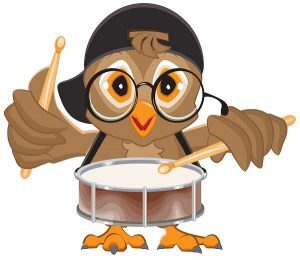
According to Sandra Scofield in her book, The Scene Book[image error], beats in fiction are “small units of character action and reaction.”
Hmm… sounds a lot like Dwight Swain’s MRUs (Motivation Reaction Units).
Beats, however, are a bit different. Instead of thinking of the something happens/something reacts pendulum of MRUs, think of beats in fiction writing more like a skeleton. Beats are the bare purpose of your scene. They are the “just the facts, ma’am” of your scene.
Here is a very short scene from book 6 in my Dusty Deals Mystery series[image error] (This is from the rough draft…)
~~~
Eight thirty the next morning, I was bouncing along a gravel road in a dilapidated bus that I assumed had once served to carry unfortunate children to some school or another. Now it was painted park ranger green and nary a child was in sight. In fact, the next youngest person on the thing was our guide and my guess was she was pushing sixty.
We were on our way to Bannack, one of Montana’s best known and most visited ghost towns. Like a lot of Montana cities, it was founded after gold was discovered there, in Bannack’s case in 1862. It was a beautiful place with a lot of history, which I loved, but getting up at 5 a.m. to get on a bus by 6, was not my idea of a vacation.
Not that this was my vacation.
I glanced around. Everyone else, whose vacation it was, seemed thrilled with themselves, chattering excitedly when someone spotted so much as a pika scrambling to hide under a rock.
As another round of yelling, pointing and crowding to one side of the moving bus ensued, I tilted back my head and sighed. Maybe early morning energy came with age.
Something to look forward to I guessed.
The bus swung into the parking lot and we bumped and groaned to a stop.
As everyone scrambled to exit, I stood and waited. My mother waved at me to get into the pack of humanity squeezed into the aisle. “We only have two hours here. Then it’s off to sapphire mining!”
I smiled with what I hoped looked like enthusiasm. Did ghost towns have coffee?
~~~
270 words or so of stuff that happens, what my main character is thinking and some description.
So where are the beats?Lucy is bouncing along on the bus. (Traveling on bus)The bus arrives at parking lot/sapphire mine.Lucy’s mother waves at her and says they only have two hours there.Lucy smiles (fake smile)That’s it. That’s the scene. All the rest? Window dressing that (hopefully) makes it fun to read. (Check out Pope in the Pool for more on that.)
Beats in Fiction Writing, Why Should You Care?Why should you care about knowing your beats? Well, some writers… I’m not saying this is you, of course, get a bit lost at times. They can get so caught up in describing how the moonlight reflects off the water or so involved in that gun battle that they forget that the main purpose of scene is to move the story forward.
By tracking your beats or going back and looking for them if you have a scene that goes nowhere.. or seems “off,” you can get your scene, your story, your book back on track. You can add all of that description and other action and still keep your scene working to move your story along. That’s a good thing. A very good thing.
Beats in Fiction Writing, One WarningBeats are action and reaction. They are not description or even emotion. What Lucy was feeling that made her give the fake smile is not a beat. Her physical representation of it, her smile, is. Make sure you show those emotions, don’t just tell us about them.
So Beats in Fiction? Any questions? Do you think in beats? Leave a comment or even an example from your own work.
~~~
Lori Devoti is the author of paranormal romance, urban fantasy and young adult fiction. Under the name Rae Davies, she writes the USA Today Bestselling Dusty Deals Mystery series. Check out her books at www.LoriDevoti.com and RaeDavies.com. Looking for help with your writing? Lori also does developmental editing and critiques for other authors and publishers. See our Editorial Services page for contact information and pricing. Or check out Lori’s classes at the Continuing Studies Department of the University of Wisconsin.
May 14, 2018
Hero’s Journey Archetypes
The more you read on writing, the more you realize most concepts go back to a few shared sources or shared ideas. Archetypes are one of those concepts. Both Joseph Campbell[image error] and Carl Jung[image error] discuss archetypes. They are basically a part of our collective unconsciousness. The same collective unconsciousness that makes The Hero’s Journey such a powerful tool for writers, and this definitely makes Hero’s Journey archetypes a concept worth discussing and possibly using in your own writing (with some warnings).
Archetypes DefinedFor Jung, archetypes were recurring themes in character that show up in the dreams of people around the world, across cultures and across time. He also noticed that these archetypes were found in various mythological tales. Because of this, he believed these archetypes weren’t something learned. They were part of who all humans are, part of a collective unconsciousness that we are born with.
Jung’s archetypes or how he saw them, don’t correlate completely with what most writers think of when they describe an archetype. Writers think of an archetype as being a particular character whereas Jung saw more than one of these archetypes existing within any particular person for them to call on when needed. Jung also had many more archetypes than you will generally see listed as character types when discussing writing and character development for writing.
Still, though, this is the basic premise of archetypical characters in writing and Hero’s Journey archetypes.
Enter The Hero’s JourneyIf you are new to The Hero’s Journey, take a little visit to my post on What is The Hero’s Journey and then scamper on back here to discuss Hero’s Journey archetypes.
All back? Okay, let’s go.
If you review the steps in The Hero’s Journey, you will see a number of archetypes/characters mentioned.
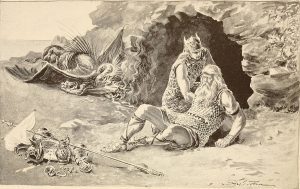
This first one is pretty obvious. It is The Hero’s journey after all. This must mean we need a hero. The number one quality a Hero’s Journey archetype hero must have is a willingness to sacrifice himself (or herself) to promote a greater good.
Main character of the story/Protagonist.Personifies a search for identity (think of Luke Skywalker’s journey and arc in Star Wars).Shows an ability to grow and change.Drives things that happen. (Although, honestly, in my opinion, Luke fell down on the job on this one.)Takes the big risks.Has a universal appeal. (The hero’s motivation is easily understandable to readers or viewers.)Willingness to give something up that is important to him to complete the journey/get the elixir for others (the self-sacrifice I mentioned).Side note: While the hero is our main character, other characters can show aspects of this archetype as well. They may not be the hero of this story, but they can become heroic and we will love them for it. (Obi Wan sacrificing himself so Luke and others can escape the Death Star.)
The MentorSpeaking of Obi Wan… The mentor is the Hero’s Journey archetype who provides guidance and knowledge to the hero. The mentor teaches the hero and brings them along under a wing until they are ready to fly.
Teaches hero the skills he needs to complete his journey.May provide the hero with gifts that will help the hero with his journey.May play the role of conscious to the hero. (Jiminy Cricket or the best friend in most romantic comedies)Motivates the hero to take on the journey. Sometimes this means pushing the hero right into the fray.HeraldThe herald lets the hero and the readers/viewers know that change is coming. They deliver the challenge or “call to adventure.”
The appearance of the Herald is when the story really begins. The Herald archetype put the call to adventure in front of the hero for him to accept or refuse.The Herald does not have to be human. This Hero’s Journey archetype could actually be an act of nature, etc.One character may play the role of the Herald and another archetype. (Mentor and Herald are a common pair.)In addition to the call to adventure, the Herald may appear later in the story as well to announce some other coming change.Threshold GuardianThe threshold guardian is an archetype who presents a challenge for the hero to overcome. He stands between the world the hero is leaving and the new world that the hero needs to enter to complete his journey. He is not the main antagonist and may even turn into an ally. Think of the dragon and his questions.
May serve as an alarm of sorts or first barrier to protect the antagonist.Tests the hero’s resolve to go on this journey and his readiness.Getting past the Threshold Guardian provides the hero with confirmation that he is meant for this journey.May teach the hero some lesson that he will utilize later.ShapeshifterShapeshifters shift shape. How’s that for a definition? This is the literal definition, but a Hero’s Journey archetype of shapeshifter does not have to be literal. It may be a character who appears to the hero as one type of person only to shift into a different type (reveal themselves as this other type) later. A femme fatale or fan/lover who later is revealed to be a stalker are two examples. (Could also go other way with a character who appears dangerous to the hero shifting into someone supportive, etc.)
Represents the need to change and may elicit change in the hero as he decides how to deal with the shapeshifter. He thought he was dealing with one thing and then…Creates questions for the hero and increases suspense for readers/viewers.The hero may need to be a shapeshifter himself to get past challenges in his journey.Tricksters are often shapeshifters as well.ShadowThe Shadow is also seen in Jung’s archetypes. For Jung, the Shadow is that part of yourself that you try to hide. It may be bad, but it may also be good, but not fit with the mask that you portray to the world. (Think tough guy persona who secretly writes poetry or girly girl who wants to drive a monster truck.) In the Hero’s Journey, the Shadow may be the villain or present itself in other characters including the hero himself. (Darth Vadar and his embracing of the dark side of the force being the most obvious villain representation of Shadow.)
Shadow isn’t necessarily completely evil. (And great villains/antagonists aren’t.)May represent some darkness that could potentially be in the hero as well. (There but for the grace of God…)Because of this shared potential, the Shadow may tempt or attract the Hero to follow his path instead.Usually, Shadow doesn’t see himself as the bad guy. He is the hero of his own story. The reader/viewer is just seeing things from the wrong (hero’s) point of view.The Shadow may be inside the hero… a man-against-self story.Trickster
Who doesn’t love a good (or not so good) trickster? The trickster is smarter than your average bear and is willing to use that intelligence against you. He may be a shapeshifter, and he is always up for some fun and mischief… possibly at cost to the hero. The trickster isn’t evil. He just is…
Teaches the reader/viewer and possibly the hero lessons on hypocrisy and works as a catalyst for change in the story.Provides humor to a story.A Trickster may be a helper, ally, or Shadow.A Trickster may even be the hero. (Brer Rabbit)The character most likely to remain unchanged by the events of the story… or are they? How would we know for sure….? (Loki… )So there you have it, a rundown of some of the most common Hero’s Journey archetypes. Do you have them in your story? Are you considering adding them? Time for my word of warning.
These Hero’s Journey archetypes are great to add to any story. They add that universal appeal that will add stability and a sense of knowing that can make a reader/viewer immediately comfortable. However, frequently there is a temptation to take one of the archetypes and go no further. It is very easy to take a variation of these archetypes, (for example, a mentor who is the wise old woman) and present them at face value only, to write a cliche.
Don’t do that. Take these lessons from myth and folklore and develop these archetypes into fully rounded characters with fears and goals and motivations. Make them real. (The Enneagram is one tool to help with this.)
Now back to the archetypes… which is your favorite? I’ve given a photographic hint as to mine…
~~~
Lori Devoti is the author of paranormal romance, urban fantasy and young adult fiction. Under the name Rae Davies, she writes the USA Today Bestselling Dusty Deals Mystery series. Check out her books at www.LoriDevoti.com and RaeDavies.com. Looking for help with your writing? Lori also does developmental editing and critiques for other authors and publishers. See our Editorial Services page for contact information and pricing. Or check out Lori’s classes at the Continuing Studies Department of the University of Wisconsin.
May 11, 2018
Plotting with The Hero’s Journey
There are many, many ways to plot a book. But, quite honestly, almost all of them… okay the good ones… all tie back in some way to The Hero’s Journey. They may use different names for the steps or plot points. They may not ask you to come up with as many steps or plot points, but the overall flow and idea came in some way from The Hero’s Journey. So no matter what plotting method you settle on for your writing, having some knowledge of plotting with The Hero’s Journey is, if not a must, a very good idea.
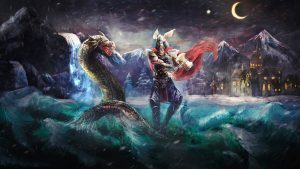
Sidenote: If you arrived at this page without really knowing what exactly The Hero’s Journey is or why writer’s love plotting with The Hero’s Journey, you may want to visit What is the Hero’s Journey? and come back.
Back?
Ready to plot?
Let’s do it.
Plotting with The Hero’s Journey, Some TipsThe Hero’s Journey contains a lot of symbolism. You can go more or less literal with this. For example The Belly of the Whale. I wouldn’t go completely literal with this. There really aren’t that many stories that call for someone being swallowed by a whale. But you can choose to put your character in a dark and scary, even damp, setting or you could just put your character in that state of mind. Both are legitimate choices. I do, though, think it is fun to try to be more literal on some of these when you can. It gives you something to play with.
Also, you can leave steps out and you can move steps around. The main thing you want to make sure of is that you maintain movement of rising and falling action in your story. You need to put your character in a place of resistance, then let up a bit… then hit him again. (I talk about this a bit in my article on The W Plot.)
Finally, as you learn more about The Hero’s Journey, you will begin to see it everywhere. Use that. Watch for it. See what steps and stages you can name in your favorite movies and books. The plot for the original Star Wars movie was written to follow The Hero’s Journey and in each step I’ve listed the matching scenes from Star Wars A New Hope.
Now, really, let’s do this…
Plotting with The Hero’s Journey – Stage One (Act One in a Three-Act Structure): DepartureOrdinary WorldLife as character knows it before the adventure begins. Often only a small slice of this is shown in modern genre fiction—or not at all. (Star Wars: Luke on the farm.)
The Call to AdventureWhen the character is first notified everything is about to change. (Star Wars: Obi-Wan “You must come with me to Alderaan”)
Refusal of the CallJust what the title says. The character’s first reaction is “no, not me.” (Star Wars: Luke says “No, I’m staying on the farm.”)
Supernatural AidAfter character commits to journey a mentor or aid appears. This meet with the mentor also might be what gives the character a nudge to commit to the journey. (Star Wars: Obi-Wan and to some degree droids.)
The Crossing of the First ThresholdThe character actually enters the new world created by taking the call. Shows the reader that the main character is somewhere new/away from the ordinary world. (Star Wars: Mos Eisley spaceport and the cantina.)
The Belly of the WhalePoint where the character is transitioning between two worlds (ordinary and new) and two selves (before changes needed to succeed at the journey and after). Often symbolized as something dark and scary…like being trapped in the belly of a whale. Character shows at this point that he is ready to die (at least let his old self die). (Star Wars: the trash compactor.)
Plotting with The Hero’s Journey – Stage Two (Act Two in a Three-Act Structure): InitiationThe Road of TrialsSeries of tests, tasks, or ordeals that the character has to undergo to begin the transformation that he came to grips with in the Belly of The Whale. The character often fails at one or more of these tasks…he is learning to become a character capable of ending the journey victorious. (Star Wars: events leading to the destruction of Death Star and rescue of Princess Leia.)
The Meeting with the GoddessPoint where the character experiences a love that is powerful and significant, like the love of a mother or the mother goddess. This may take place within the character—a marriage of sorts of his two halves, spiritual and physical or this may be represented by the character loving another character in this all-encompassing way. (Unconditional love and/or self-unification) (Star Wars: Luke’s feelings for Princess Leia.)
Woman as the TemptressDoes not have to be a woman, but something that represents the hero’s need to step away from his physical/earthly needs. This is, however, often shown with a woman, the lust the hero feels for her, and his own disgust over this lust that could pull him away from his journey. (Star Wars: Princess Leia is both Goddess and Temptress.)
Atonement with the FatherThis is the midpoint in the journey. The character confronts and is initiated by whatever holds the most power in his life—taking on the father to become a man of his own. Everything has led us to this point. It is where the character proves he is capable of going on alone. Character’s old self dies at this point, sometimes literally. (Star Wars: Luke puts aside the computer and lets the force lead him.)
ApotheosisPoint of divine knowledge after death. In modern fiction short this is a period of peace and fulfillment before the character begins the final stage of the journey. (Star Wars: Luke’s high after putting aside the computer.)
The Ultimate BoonAchievement of the goal of the journey. (Star Wars: Things look bad for the Death Star and Luke understands the ways of the Force.)
Plotting with The Hero’s Journey – Stage Three (Act Three in a Three-Act Structure): ReturnRefusal of the ReturnThe character may not want to return from the journey.He may think of staying in this new place.
The Magic FlightThe character may have to escape with the “boon” while others give chase. (Star Wars: Luke is chased by Millennium Falcon.)
Rescue from WithoutGuide or assistant who helps bring the character back to the world or convinces them they need to bring the “boon” to the world. (Star Wars: Hans Solo returns to save Luke from being blown up.)
The Crossing of the Return ThresholdThe character returns to the old world, often to find it changed. Getting “boon” to work for this world may prove difficult. (Star Wars: We don’t see Luke return to his original world, the farm, but we know this world has changed from the earlier scene where the farm was destroyed. We do see Luke return to the rebel base, his new world.)
Master of the Two WorldsCharacter hits the balance between spiritual and material worlds/inner and outer worlds. (Star Wars: Luke is star pilot but can also use the Force.)
Freedom to LiveThe character is master of his own destiny, capable of living in the moment, free from fear of death and doesn’t regret the past or worry about the future.
Those are all the stages of The Hero’s Journey. Are you a convert? Post any questions you have in the comments and let me know how you plan to use The Hero’s Journey when plotting your next book! Or maybe you will use it for inspiration…
Want more? Read up on Hero’s Journey Archetypes. Looking for more help developing a plot for your book? Check out my how-to guide: Hello, Plot. Are You Out There?
~~~
Lori Devoti is the author of paranormal romance, urban fantasy and young adult fiction. Under the name Rae Davies, she writes the USA Today Bestselling Dusty Deals Mystery series. Check out her books at www.LoriDevoti.com and RaeDavies.com. Looking for help with your writing? Lori also does developmental editing and critiques for other authors and publishers. See our Editorial Services page for contact information and pricing. Or check out Lori’s classes at the Continuing Studies Department of the University of Wisconsin.
May 9, 2018
What is The Hero’s Journey?
What is The Hero’s Journey? It depends on who you ask. To a writer, it’s a plotting method. To fans of mythology and folklore, it’s a narrative pattern that human storytellers have followed since we had human storytellers. Which brings us back to why writers use it so much as a plotting method.
What is The Hero’s Journey?

In his book, The Hero with a Thousand Faces, American mythologist, and author, Joseph Campbell introduced us to the idea of The Hero’s Journey. This “journey” describes basic stages that heroes in quest-type stories go through in tales told across the world and for generations.
The patterns found in these stories are so consistent and so ancient, Campbell believed that they called out to something deep within all of us, something universal and never-changing.
His ideas of the hero and the characters that the hero encounters correspond with the teachings of Carl Jung[image error]. Both see archetypes in quest stories, characters who reoccur in dreams, stories, and myths. Jung believed that these archetypes were part of our “collective unconscious.”
This is why stories that follow The Hero’s Journey with the quest archetypes have such power to grab readers and viewers. They are speaking to something basic and universal.
Intrigued?If you want to go to the original source, read The Hero with a Thousand Faces and check out the documentary that Campbell did with Bill Moyers, The Power of Myth.
If you are approaching The Hero’s Journey as a fiction writing plotting method, you may also want to check out (or just go straight to) The Writer’s Journey by Christopher Vogler. Vogler takes Campbell’s Hero’s Journey and simplifies it for writers.
Or you can just read my breakdown of each step and stage of The Hero’s Journey… or maybe all of the above.
What is The Hero’s Journey, DisclaimerWhen you research the Hero’s Journey or any of the plotting structures based on it, you will find the same general ideas called many different things. As Shakespeare would tell you, names don’t matter. Look at what the stage actually shows and decide if it is right for your story. You may want to skip some. You may also want to move some. Use the Hero’s or Writer’s or whatever other Journey as a guide, not a law.
You will also see that The Hero’s Journey has more steps with more symbolism than The Writer’s Journey or other plotting structures. For some stories, it can be a lot of fun to try and work these in. For example, can you think of a Belly of the Whale scene? Or a Magic Flight? If you can and it adds to your story, give it a try, but don’t force things. Use what works for you and your story.
Ready to plot with The Hero’s Journey?Let’s go to those plot points.
~~~
Lori Devoti is the author of paranormal romance, urban fantasy and young adult fiction. Under the name Rae Davies, she writes the USA Today Bestselling Dusty Deals Mystery series. Check out her books at www.LoriDevoti.com and RaeDavies.com. Looking for help with your writing? Lori also does developmental editing and critiques for other authors and publishers. See our Editorial Services page for contact information and pricing. Or check out Lori’s classes at the Continuing Studies Department of the University of Wisconsin.
May 4, 2018
How to Plot a Book – The W Plot
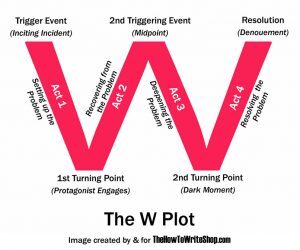 One of the most frequent questions I get is “How do I plot a book?” The answer, honestly, is that there are tons of different ways successful writers plot (or don’t plot) books. Personally, I am a strong believer in having some kind of a plot to guide you before you start writing. I even work with small presses and individual writers, reviewing plots they have developed and telling them what I think is missing or will cause them problems as they start to write. (I poke holes in their plot, and yes, it’s fun… evil laugh) But I know all writers are different and I am also a strong believer in each writer finding what works for them. With that in mind, I thought I’d go over a method a number of writers love and swear by. The W Plot.
One of the most frequent questions I get is “How do I plot a book?” The answer, honestly, is that there are tons of different ways successful writers plot (or don’t plot) books. Personally, I am a strong believer in having some kind of a plot to guide you before you start writing. I even work with small presses and individual writers, reviewing plots they have developed and telling them what I think is missing or will cause them problems as they start to write. (I poke holes in their plot, and yes, it’s fun… evil laugh) But I know all writers are different and I am also a strong believer in each writer finding what works for them. With that in mind, I thought I’d go over a method a number of writers love and swear by. The W Plot.
(But you wouldn’t have to use it with a storyboard if you didn’t want to.) In fiction writing, storyboarding is when a writer creates a visual of their story. Usually, this is using something like Post-it Notes that you stick on a whiteboard (or something similar) and then move the Post-its around as you visualize and tweak the story to follow a desirable arc.
The W Plot also has some similarities to the Clothesline Plot.On the image in this article, I listed the Clothesline equivalent for the W points. (Although the Clothesline doesn’t include the Denouement.)
The W Plot is based on a 4 Act Structure.You have probably heard of the 3 Act Structure which dates back to Aristotle and is extremely popular, especially with screenwriters.
With the 3 Act Structure, the acts are not the same length. Th first and third acts are shorter than the 2nd where the meat of the story occurs.
The W Plot (4 Act Structure) cuts that 2nd act in two which forces the writer to focus on rising and falling action more. (As you can probably tell, I like this way of looking at story better.)
The W Plot, like most plotting methods, is a combination of other ideas, not something unique to itself.I mention this, not to slam The W Plot method, I think it is a great method. But to assure you that if have never heard of it before, you weren’t walking around with a gaping hole in your writing education. :)
How to use The W PlotFirst, let’s review the Five Points on The W PlotTrigger Event – (same as the Inciting Incident in a number of other plotting methods. It’s when something happens that puts the protagonist on the main journey of the book/story. (Check the article linked to in this item for more detail.) In The W Plot this is followed by Setting up the Problem that the protagonist will need to solve.1st Turning Point – A turning point, in general, is an event (scene) that changes the protagonist’s (or story’s) direction. In The W Plot, this occurs at the end of a period of falling action. The protagonist starts out all fired up, discovering new things about the problem, learning what the problem is. She thinks she has a direction to go and then…. wait… something happens that changes where she thought she was going or how she thought she was going to get there. With a revised plan in hand, she goes back to the path and another period of rising action called Recovering from the Problem. (I’m not a huge fan of this term because I find it confusing as to what problem it means. The big overall problem cannot have been solved at this point, or it wasn’t the big overall problem. I might call it renewing the fight or something to that effect.)2nd Triggering Event – (Midpoint in a number of other plotting methods) At this point some new question is raised or some new event happens that sends the protagonist in a completely new direction. This event is big. The protagonist may even discover a new goal here. (In The Wizard of Oz, Dorothy reaches the Emerald City and learns she has to kill the witch. Her overall goal remains the same, to get home, but her mini goal switches.) This is followed by a deepening of the problem. She has this new goal or new way she has to use to hit the original goal… things get rough.2nd Turning Point – (Dark Moment in other plotting methods) This is the emotional low of the story. All is lost. There is no way that your character (or hopefully the reader) can see for her to reach her goal. But she must… or at least try to. This is followed by the Resolving of the Problem where she rises up to fight and faces down the antagonist.Resolution – (or Denoument) All is well, or not. The battle is over and your protagonist has either won the fight or lost. We see the world as it is now/after the journey.For the Non-Plotters/PantsersAs I said above, The W Plot is really meant for storyboarding. It’s meant as a method for those of you who think of scenes or ideas without knowing how they will all fit together. If this is how you write, here is how to use The W Plot to organize those ideas and scenes into an actual story.
Write a short description of the scene or idea on a Post-it Note.[image error] “Hero falls in well.” “Heroine’s dog finds hero in well.”Do this for all of your ideas and scenes.Draw a W on a whiteboard or posterboard or paint it on your wall!Mark the points listed in the image on the W or just have this out for reference.Divide your Post-its into either rising (things are going good ) or falling (things are going downhill) actions. You will also want to have an idea of where in the story you want these events to happen.Stick them on along the W legs as looks good to you.Step back. What are the BIG moments you have? Do you have five to fit the plot points? If not, come up with some.Move things around. Look for gaps.Come up with new ideas. Discard some ideas.That’s it. You’ve plotted your book with The W plot.
For the PlotterThe plotter may not need the storyboard aspect of this. For you, concentrate on coming up with the plot points and some scenes that fit on the legs.
Have you tried The W Plot? What about it works for you? What doesn’t work for you?
Resources from other sites:The Four Act Structure (There is one error in this article that is fairly important. She says, “the third act is as long as the first and third acts combined.” I believe she meant the “second act is as long as..”)
Storyboarding This is by author Mary Carroll Moore[image error] who many credit with creating The W Plot. In it is a video that she did describing this plotting method.
~~~
Lori Devoti is the author of paranormal romance, urban fantasy and young adult fiction. Under the name Rae Davies, she writes the USA Today Bestselling Dusty Deals Mystery series. Check out her books at www.LoriDevoti.com and RaeDavies.com. Looking for help with your writing? Lori also does developmental editing and critiques for other authors and publishers. See our Editorial Services page for contact information and pricing. Or check out Lori’s classes at the Continuing Studies Department of the University of Wisconsin.



